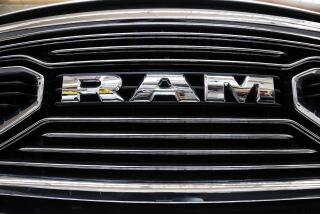5.8 Million GM Truck Owners to Get Compensation
- Share via
Ending years of legal stalemate, General Motors Corp. said it will begin mailing notices today to current and former owners of 5.8 million older pickups who quality for discounts of $250 to $1,000 on new GM vehicles as part of a massive class-action settlement.
The coupon offer is the centerpiece of a long-delayed settlement of suits filed in 1992 that claimed defective fuel systems made millions of GM trucks more prone to catching fire or exploding in collisions.
Instructions on ordering discount coupons are being sent to owners of GM C/K pickups, model years 1973-86, and R and V model pickups built from 1987-91. Only those who owned the trucks in July 1996, when the agreement was completed, are eligible.
The settlement, approved by a Louisiana state court, is believed to be the largest in an automotive case in terms of the number of class-action members. But the cost to GM of honoring the discounts could range from less than $100 million to over $1 billion, depending on how many coupons are redeemed.
GM, which did not admit liability, also is required to provide $4.1 million for research on reducing the risk of vehicle fires.
The agreement allows class-action members to claim a discount of $1,000 on a new GM car or truck on top of other rebates or incentives. However, if the coupon is transferred to a third party, its value will drop to $250, or to $500 when no other discount is offered on a vehicle.
Although the basic terms of the settlement were set five years ago, bickering over transferability of the coupons continued until recently. The transfer rules are crucial because they determine how many class-action members will benefit as well as the total value of certificates GM will have to redeem.
Such coupon settlements have come under criticism in the past, in part because relatively few class-action members have been in a position to take advantage of a coupon offer. In this case, probably only a fraction of those who qualify will purchase a new GM vehicle for a $1,000 cut in price.
As a result, plaintiffs’ lawyers and consumer groups have sought to create a secondary market for the certificates, sparking a conflict with GM and delaying implementation of the deal.
A new business, Certificate Redemption Group, has been established to buy and resell the coupons of class-action members who can’t use them and have no other market. James Dawley, a former insurance man who runs CRG, says the firm will pay $100 for coupons, with the intention of offering them for $150 to $200 apiece to buyers such as fleet operators, leasing firms and dealers, who may be able to use the coupons as incentives to close a sale.
Dawley said a new Web site explaining the offer will start up Thursday at https://www.certificatedepot.com, adding that information also will be available to those calling (800) 317-4997.
How many class-action members take advantage will depend on “how many hoops they have to jump through,” said Fabrice Vincent of Leiff, Cabraser, Heimann & Bernstein, one of the plaintiffs’ law firms.
Plaintiffs’ attorneys had hoped to simplify the process by allowing class-action members to call an 800 number to have their certificates transferred to CRG.
But GM insisted on following to the letter the agreement that the discount coupons be issued to class-action members.
This means that those wishing to transfer their coupons must go through some red tape. First, they will have to mail in claim forms to get their certificate. Then they will have to send a request to transfer ownership of their coupon to a third party, such as an individual or CRG.
The certificates were meant “to encourage and provide consideration for people who actually own these trucks to be able to get $1,000 toward a new vehicle,” said GM lawyer Lee Schutzman. The purpose was not “to get someone else to use [the coupons] so they can derive money” from them.
A series of class-action suits were filed after claims that the placement of the fuel tanks outside the protective frame rails of the trucks had resulted in scores of serious injuries and deaths from post-collision fires. GM built more than 9 million of the full-size pickups with the side-saddle fuel tank design from 1973-87 and used the design on a much smaller number of R and V model trucks through the ’91 model year.
The lawsuits coincided with a major investigation by the National Highway Traffic Safety Administration of the fuel system design. The NHTSA concluded in 1994 that the trucks did have an elevated fire risk, but rather than recall them, it reached a $51 million settlement with GM.






